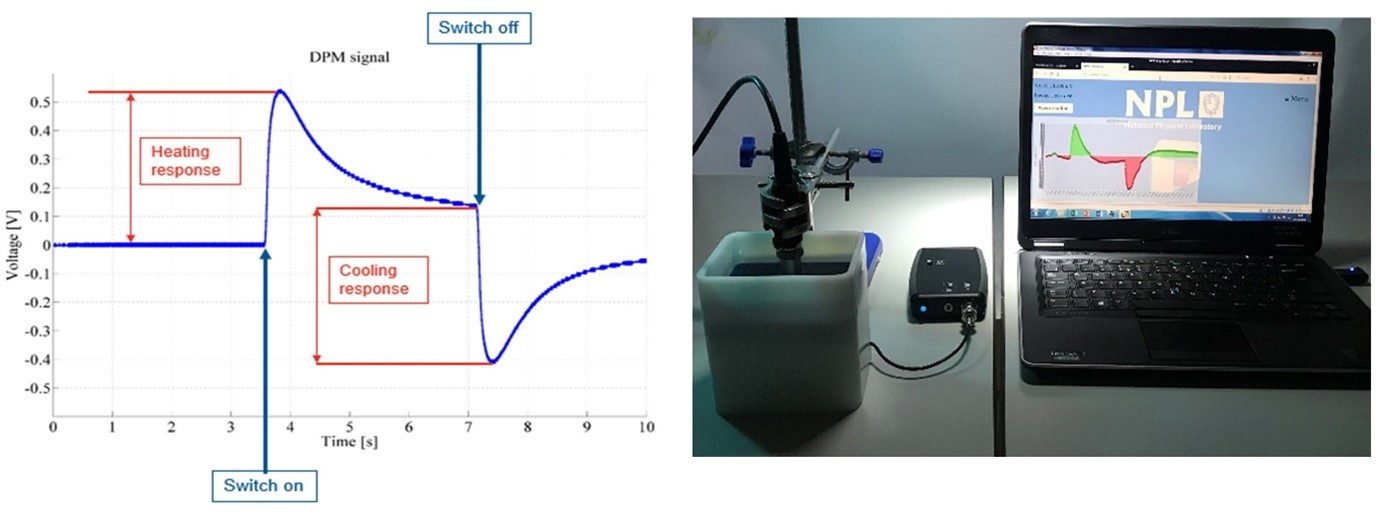Ultrasound (US) is widely used in diagnostic medical imaging. Its popularity is mainly due to its low-cost, portability, and use of non-ionising radiation. It also produces images with better spatial resolution compared to MRI and CT. Normally, during an ultrasound examination, a probe (transducer) is placed directly on the skin with the help of a water-based coupling gel. To make sure that the probe is operating within specification, it should be routinely checked for damage, and periodically, its acoustic output assessed. Acoustic power is an important safety parameter, as it correlates with the likely increase of temperature in tissue during US application. Acoustic power can also be a quick indicator of the overall working conditions of the system. Power measurement methods usually require the device (such as an ultrasound imaging system) to be taken outside of the hospital environment to test houses and laboratories such as NPL which results in health service downtime.
Currently a Radiation Force Balance (RFB) system is used to calibrate the acoustic power of ultrasound probes. RFB’s are relatively costly, sensitive to mechanical vibrations and air drafts, and are bulky and fragile, making transport challenging. There is a need for a relatively low-cost, easy-to-use technology, that can measure the acoustic power delivered by ultrasound probes; for example on manufacturing production lines and hospitals.
The pyroelectric-based Diagnostic Power Meter (DPM) is an advanced prototype of a portable, compact and cost-effective device, specifically developed by NPL. It has been refined to measure total acoustic power from medical ultrasound probes in non-laboratory environments. The pyroelectric effect is the ability of a material to generate a voltage when heated or cooled. Ultrasound is applied to a thin film of pyroelectric material with an absorbing backing, and the absorption of ultrasound within the layers gives rise to heat, which in-turn generates a voltage across the film. An electronic circuit connected to the film extracts the generated voltage. Heating and cooling voltage amplitudes are proportional to the applied power.

The image shows the DPM. It has a sensor integrated into a control unit, which provides signal acquisition, conditioning and data analysis capability. The sensor backing material maximises temperature elevation, which allows the assessment of acoustic powers as low as a few mW with a precision of 0.2 mW.
The DPM can be used in a hospital environment or by equipment manufacturers in an inline/online setup to assess the acoustic power produced by ultrasound probes. As recommended by the British Medical Ultrasound Society, we anticipate that it will be used as a rapid and accurate means of measuring power to check for the repeatability of performance and potential damage to probes. Previously, audits carried out by NPL in a select number of UK hospitals, highlighted possible thermal hazards associated with clinical use of ultrasound probes, particularly for foetal applications. This demonstrated how important it is to ensure these devices are compliant with safety standards. The ability of the prototype device to assess the acoustic power in hospital environments has also caught the attention of the medical physics community, who understand the benefit of having an accessible system provides a simple, in-house means to routinely monitor the safety performance of their probes, providing confidence for clinicians.
This new capability was developed under the NPL MedAccel programme.
Find out more about the NPL MedAccel programme
Find out more about NPL’s ultrasound research
Find out more about NPL’s ultrasound products and services
Find out more about how NPL helps the Healthcare sector
Find out more about how NPL helps the Life Sciences sector
Find out more about how NPL is tackling health challenges
Find out more about how NPL is supporting medical devices and new technology for patients
The DPM is a battery-operated, portable, compact, and low-cost device for measuring total acoustic power from medical ultrasound scanners. Acoustic energy is absorbed close to the surface of a pyroelectric polymer film, which results in a rapid temperature rise across the film. The generated pyroelectric voltage is proportional to the rate of temperature rise, which in turn is proportional to the time-averaged power absorbed by the sensor.
The DPM is designed to operate in the frequency range 3-15 MHz and 10-200 mW time-averaged power. The DPM is accurate to within 10% of RFB-based measurements. The system can accommodate 2D array transducers with a footprint of up to 75 mm x 15 mm (length x width).